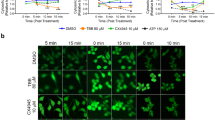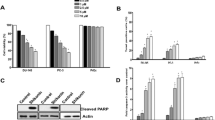Abstract
Triterpenoids are a novel class of compounds being investigated as potential therapeutic agents for the treatment of prostate cancer and other malignancies. Asiatic acid (AA) is a member of the ursane family of triterpenoids and has anticancer activity, but its mechanism of action is not completely understood. To investigate its mechanism of action, PPC-1 prostate cancer cells were treated with AA at increasing concentrations and times. AA induced rapid caspase-dependent and independent cell death that peaked within 8 h of treatment. AA-induced death was associated with early activation of caspases 2, 3, and 8, but not caspase 9. Within 2.5 h of treatment, release of calcium from intracellular stores and dilatation of the endoplasmic reticulum was observed. Thus, disruption of the endoplasmic reticulum and alterations in calcium homeostasis are early events in AA-induced death.
Similar content being viewed by others
References
Schimmer A, Hedley DW, Penn LZ, Minden MD (2001) Receptor- and mitochondrial-mediated apoptosis in acute leukemia: a translational view. Blood 98:3541–3553
Schimmer AD (2004) Inhibitor of apoptosis proteins: translating basic knowledge into clinical practice. Cancer Res 64(20):7183–7190
Mattson MP, LaFerla FM, Chan SL, Leissring MA, Shepel PN, Geiger JD (2000) Calcium signaling in the ER: its role in neuronal plasticity and neurodegenerative disorders. Trends Neurosci 23(5):222–229
Rao RV, Ellerby HM, Bredesen DE (2004) Coupling endoplasmic reticulum stress to the cell death program. Cell Death Differ 11(4):372–380
Sperandlo S, de Belle I, Bredesen DE (2000) An alternative, nonapoptotic form of programmed cell death. Proc Natl Acad Sci USA 97:14376–14381
Broker LE, Kruyt FA, Giaccone G (2005) Cell death independent of caspases: a review. Clin Cancer Res 11(9):3155–3162
Maquart FX, Chastang F, Simeon A, Birembaut P, Gillery P, Wegrowski Y (1999) Triterpenes from Centella asiatica stimulate extracellular matrix accumulation in rat experimental wounds. Eur J Dermatol 9(4):289–296
Grimaldi R, De Ponti F, D'Angelo L, Caravaggi M, Guidi G, Lecchini S, et al. (1990) Pharmacokinetics of the total triterpenic fraction of Centella asiatica after single and multiple administrations to healthy volunteers. A new assay for asiatic acid. J Ethnopharmacol 28(2):235–241
Hsu YL, Kuo PL, Lin LT, Lin CC (2005) Asiatic acid, a triterpene, induces apoptosis and cell cycle arrest through activation of extracellular signal-regulated kinase and p38 mitogen-activated protein kinase pathways in human breast cancer cells. J Pharmacol Exp Ther 313(1):333–344
Park BC, Bosire KO, Lee ES, Lee YS, Kim JA (2005) Asiatic acid induces apoptosis in SK-MEL-2 human melanoma cells. Cancer Lett 218(1):81–90
Berube C, Boucher LM, Ma W, Wakeham A, Salmena L, Hakem R, et al. (2005) Apoptosis caused by p53-induced protein with death domain (PIDD) depends on the death adapter protein RAIDD. Proc Natl Acad Sci USA 102(40):14314–14320
Schimmer AD, Welsh K, Pinilla C, Wang Z, Krajewska M, Bonneau MJ, et al. (2004) Small-molecule antagonists of apoptosis suppressor XIAP exhibit broad antitumor activity. Cancer Cell 5(1):25–35
Pedersen IM, Kitada S, Schimmer A, Kim Y, Zapata JM, Charboneau L, et al. (2002) The triterpenoid CDDO induces apoptosis in refractory CLL B-cells. Blood 100:2965–2972
Carter BZ, Gronda M, Wang Z, Welsh K, Pinilla C, Andreeff M, et al. (2005) Small-molecule XIAP inhibitors derepress downstream effector caspases and induce apoptosis of acute myeloid leukemia cells. Blood 105(10):4043–4050
Bradford MM (1976) A rapid and sensitive for the quantitation of microgram quantitites of protein utilizing the principle of protein-dye binding. Analy Biochem 72:248–254
Schimmer AD, Hedley DW, Chow S, Pham NA, Chakrabartty A, Bouchard D, et al. (2001) The BH3 domain of BAD fused to the Antennapedia peptide induces apoptosis via its alpha helical structure and independent of Bcl-2. Cell Death Differ 8(7):725–733
Vayro S, Lo B, Silverman M (1998) Functional studies of the rabbit intestinal Na+/glucose carrier (SGLT1) expressed in COS-7 cells: evaluation of the mutant A166C indicates this region is important for Na+-activation of the carrier. Biochem J 332(Pt 1):119–225
Furuya Y, Lundmo P, Short AD, Gill DL, Isaacs JT (1994) The role of calcium, pH, and cell proliferation in the programmed (apoptotic) death of androgen-independent prostatic cancer cells induced by thapsigargin. Cancer Res 54(23):6167–6175
Suh WS, Kim YS, Schimmer AD, Kitada S, Minden M, Andreeff M, et al. (2003) Synthetic triterpenoids activate a pathway for apoptosis in AML cells involving downregulation of FLIP and sensitization to TRAIL. Leukemia 17(11):2122–2129
Kim Y, Suh N, Sporn M, Reed JC (2002) An inducible pathway for degradation of FLIP protein sensitizes tumor cells to TRAIL-induced apoptosis. J Biol Chem 277:22320–22329
Konopleva M, Tsao T, Estrov Z, Lee RM, Wang RY,Jackson CE, et al. (2004) The synthetic triterpenoid 2-cyano-3,12-dioxooleana-1,9-dien-28-oic acid induces caspase-dependent and -independent apoptosis in acute myelogenous leukemia. Cancer Res 64(21):7927–7935
Zou W, Liu X, Yue P, Zhou Z, Sporn MB, Lotan R, et al. (2004) c-Jun NH2-terminal kinase-mediated up-regulation of death receptor 5 contributes to induction of apoptosis by the novel synthetic triterpenoid methyl-2-cyano-3,12-dioxooleana-1, 9-dien-28-oate in human lung cancer cells. Cancer Res 64(20):7570–7578
Ikeda T, Nakata Y, Kimura F, Sato K, Anderson K, Motoyoshi K, et al. (2004) Induction of redox imbalance and apoptosis in multiple myeloma cells by the novel triterpenoid 2-cyano-3,12-dioxoolean-1,9-dien-28-oic acid. Mol Cancer Ther 3(1):39–45
Bunpo P, Kataoka K, Arimochi H, Nakayama H, Kuwahara T, Vinitketkumnuen U, et al. (2005) Inhibitory effects of asiatic acid and CPT-11 on growth of HT-29 cells. J Med Invest 52(1/2):65–73
Lee YS, Jin DQ, Kwon EJ, Park SH, Lee ES, Jeong TC, et al. (2002) Asiatic acid, a triterpene, induces apoptosis through intracellular Ca2+ release and enhanced expression of p53 in HepG2 human hepatoma cells. Cancer Lett 186(1):83–91
Lam M, Dubyak G, Chen L, Nuñez G, Miesfeld RL, Distelhorst CW (1994) Evidence that Bcl-2 represses apoptosis by regulating endoplasmic reticulum-associated Ca2+ fluxes. Proc Natl Acad Sci USA 91:6569–6573
Szabadkai G, Simoni AM, Rizzuto R (2004) Mitochondrial Ca2+ uptake requires sustained Ca2+ release from the endoplasmic reticulum. J Biol Chem 278(17):15153–15161
Lin KF, Chang RC, Suen KC, So KF, Hugon J (2004) Modulation of calcium/calmodulin kinase-II provides partial neuroprotection against beta-amyloid peptide toxicity. Eur J Neurosci 19(8):2047–2055
Zhang QH, Sheng HP, Loh TT (2001) bcl-2 protects HL-60 cells from apoptosis by stabilizing their intracellular calcium pools. Life Sci 68(25):2873–2883
Author information
Authors and Affiliations
Corresponding author
Rights and permissions
About this article
Cite this article
Gurfinkel, D.M., Chow, S., Hurren, R. et al. Disruption of the endoplasmic reticulum and increases in cytoplasmic calcium are early events in cell death induced by the natural triterpenoid Asiatic acid. Apoptosis 11, 1463–1471 (2006). https://doi.org/10.1007/s10495-006-9086-z
Published:
Issue Date:
DOI: https://doi.org/10.1007/s10495-006-9086-z




